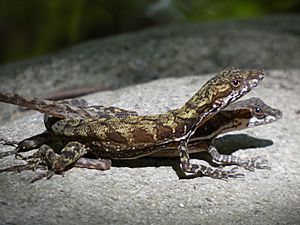Lion anole facts for kids
Quick facts for kids Lion anole |
|
|---|---|
 |
|
| A male and female | |
| Conservation status | |
| Scientific classification | |
| Genus: |
Anolis
|
| Species: |
lionotus
|
The lion anole (Anolis lionotus) is a fascinating type of lizard. It belongs to the Dactyloidae family. This small reptile is known for living in the warm, humid country of Panama.
Contents
About the Lion Anole
The lion anole is a unique lizard species. It was first described by a scientist named Edward Drinker Cope in 1861. These anoles are part of a large group of lizards. They are often found in tropical forests.
What Does It Look Like?
Lion anoles are typically small to medium-sized lizards. They have a slender body. Their skin color can vary. It often helps them blend into their surroundings. Like many anoles, they have special pads on their toes. These pads help them grip surfaces. They can climb trees and rocks very well.
Where Does It Live?
This species of anole is found only in Panama. This means it is endemic to Panama. It prefers tropical rainforests. These forests have lots of trees and high humidity. Anoles often live on tree trunks or in the leafy canopy. They like places with plenty of hiding spots.
What Does It Eat?
Lion anoles are mostly insect eaters. They hunt small insects and other tiny creatures. Their diet might include crickets, spiders, and beetles. They are quick hunters. They use their excellent eyesight to spot prey.
Life Cycle and Reproduction
Like other lizards, lion anoles lay eggs. The female anole finds a safe spot to lay her eggs. This is usually in soft soil or under leaf litter. The eggs hatch after some time. Baby anoles are very small when they hatch. They look like tiny versions of the adults. They must quickly learn to find food and avoid predators.
How Does It Live?
Lion anoles are active during the day. They spend their time looking for food. They also watch out for predators. Birds, snakes, and larger lizards might hunt them. Anoles communicate with each other. They use head bobs and dewlap displays. A dewlap is a colorful flap of skin under their chin. They flash it to show off or warn others.
Protecting the Lion Anole
The lion anole is currently listed as a species of "Least Concern." This means it is not in immediate danger of extinction. However, like many animals, its habitat can be threatened. Protecting rainforests is important for these lizards. It helps them and many other species survive.
See also
 In Spanish: Anolis lionotus para niños
In Spanish: Anolis lionotus para niños


